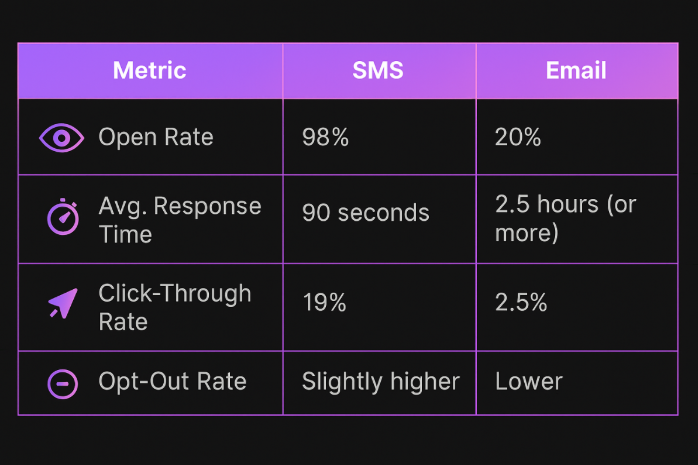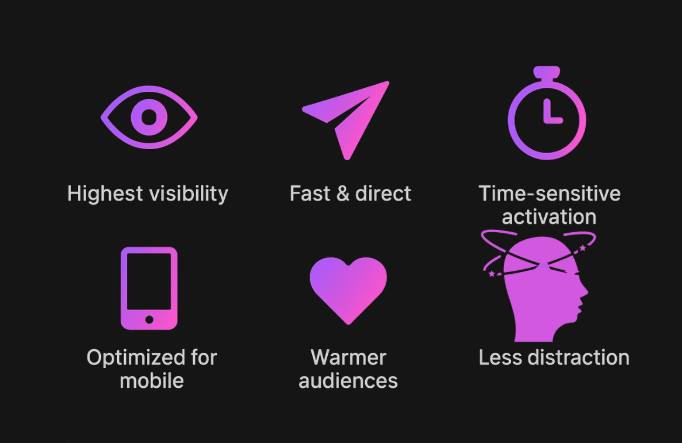August 14, 2025
4 minutes read
SMS vs Email Marketing Campaigns: Which Works Better for Your Business?

Marketers can often get stuck when they need to make a choice on SMS or email marketing campaigns, and it’s clear why. Both are direct, cost-effective channels with massive reach and proven ROI.
This article, brought to you by TopMessage, compares SMS campaign and email campaign strategies in detail - what they’re best at, when to use each, and why companies that prioritize action over noise are increasingly leaning into SMS.
Comparing the Core Metrics: SMS Campaign vs Email Campaign
At a glance, both SMS and email appear effective. But their performance in actual engagement tells a different story. Here’s how the two stack up on key campaign metrics:

These numbers make it clear - SMS marketing campaigns outperform email in immediacy, visibility, and interaction. Emails may offer more real estate for content, but that space is wasted if the message never gets opened.
Most users scroll through hundreds of unopened emails but rarely leave a text unread. And, for any marketer, needless to say, this is a critical advantage.
SMS Campaign Strengths: Where It Really Shines
If you are seeking guaranteed visibility and fast results, SMS delivers measurable value across several fronts.
1. Second to None Visibility
Text messages go straight to the SMS inbox, bypassing spam filters and crowded email tabs. With nearly 98% of messages opened (and most within minutes) SMS practically guarantees attention.
2. Fast, Direct, and Conversational
SMS connects on a human level. The format is inherently personal and feels more like a conversation than a broadcast. This drives faster engagement and stronger response rates compared to other channels.
3. High Engagement for Time-Sensitive Promotions
Flash sales, appointment confirmations, or last-minute reminders thrive in SMS. It reaches people when it matters most, which is right before they act.
4. Better Mobile Optimization
No formatting issues, no broken designs. SMS is built for mobile and doesn’t depend on screen size, image rendering, or app compatibility to get the message across. It just works.
5. Opt-in Behavior = Warmer Audiences
Users who subscribe to receive texts are typically more engaged. They’ve given clear permission, which leads to higher intent and better conversion rates.
6. Lower Distraction Environment
Unlike email, where the marketing campaign revolves around the content that competes with newsletters, receipts, and updates, texts arrive in a relatively uncluttered space, making each message more likely to be seen and acted upon.

When Email Still Holds Value
Of course, there are situations where SMS doesn’t win the battle, or otherwise, “SMS or email marketing campaigns” wouldn’t even be a debate.
Email still plays an important role in a well-rounded strategy. While it may not compete with SMS for urgency, it remains the go-to platform for deeper engagement and richer content delivery.
Here’s when it works best for:
- Long-form content like educational newsletters, case studies, or how-to guides. These formats require space and structure, and that is simply something SMS isn’t designed for.
- Visually rich promotions with multiple products, banners, and embedded links. Email shines when showcasing visual storytelling or multi-offer deals.
- Complex customer journeys, like onboarding sequences or re-engagement flows, where multiple steps and content pieces are needed to build trust over time.
- B2B communication or contexts where a formal tone, branding elements, and attachments are necessary.
- Archivable or reference content, like invoices, terms of service, or reports that users may want to save or search for later.
Still, email’s effectiveness depends heavily on deliverability and timing. Promotions often land in Gmail’s “Promotions” tab, where open rates drop significantly. And unless you’re offering high-value content, many emails get ignored altogether.
Choosing the Right Tool for the Right Message
Both SMS and email serve different roles in a balanced communication strategy. The key to making a choice on SMS or email marketing campaigns is to match the channel to the intent of the message.
Think of it like this: SMS is a tap on the shoulder - quick, personal, and hard to ignore.
On the other hand, email is a letter in the mailbox - detailed, informative, but easily overlooked if the timing isn’t right.
Insider Tip: Use SMS for "First Touch" Attention, Then Nurture by Email
Experienced marketers know how valuable it is to capture attention fast, and SMS is the ultimate first-touch channel.
Send a brief, compelling message via SMS to drive the first click, then use email for deeper follow-up.
For example:
- A customer signs up for a service.
- An SMS welcomes them instantly with a CTA or offer.
- Follow-up emails provide context, value, and retention content.
This two-step approach uses the strengths of both formats while keeping engagement high across the customer journey.
Final Thoughts: Which Channel Wins?
When comparing SMS campaign vs email campaign, at this point, it’s pretty obvious that for most action-driven goals, SMS provides clearer, faster wins. It ensures your message gets seen, drives response, and reaches audiences in the moment.
Still, the best strategy isn’t just about choosing one over the other. It’s about knowing when and how to use each. Email holds its ground for in-depth messaging, but SMS dominates in urgency, clarity, and response.
FAQs
Is SMS marketing more expensive than email?
Yes, SMS marketing is more expensive per message (typically €0.03 to €0.10) compared to the low per-email cost of bulk email platforms. However, SMS delivers much higher open and conversion rates, often 6–8 times higher than email.
As a result, the cost per conversion is often lower with SMS, especially for time-sensitive or high-impact campaigns.
What’s the best time to send SMS vs email?
SMS is best sent during peak activity hours (late mornings, lunch breaks, early evenings). Email performs better in early morning or mid-week time slots, depending on your audience's habits.
Can SMS and email be used together effectively?
Absolutely. Combining both lets you maximize engagement. SMS grabs attention, email adds depth. Used together, they cover both immediacy and content richness.
How do you build a compliant SMS list?
Use opt-in forms on your website, checkout pages, or keyword-based SMS signups. Make sure users are clearly consenting to receive messages, and always offer an easy opt-out option.
Final Thoughts: Which Channel Wins?
When comparing SMS campaign vs email campaign, at this point, it’s pretty obvious that for most action-driven goals, SMS provides clearer, faster wins. It ensures your message gets seen, drives response, and reaches audiences in the moment.
Still, the best strategy isn’t just about choosing one over the other. It’s about knowing when and how to use each. Email holds its ground for in-depth messaging, but SMS dominates in urgency, clarity, and response.